
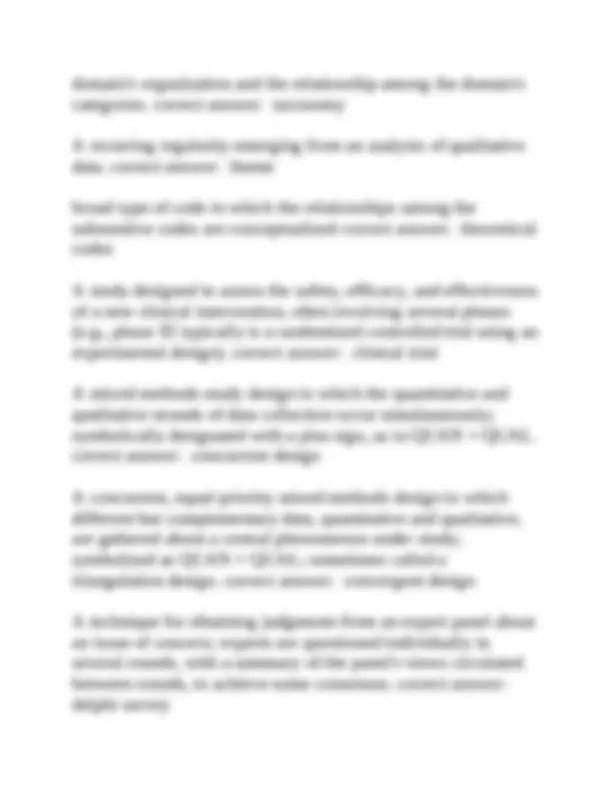
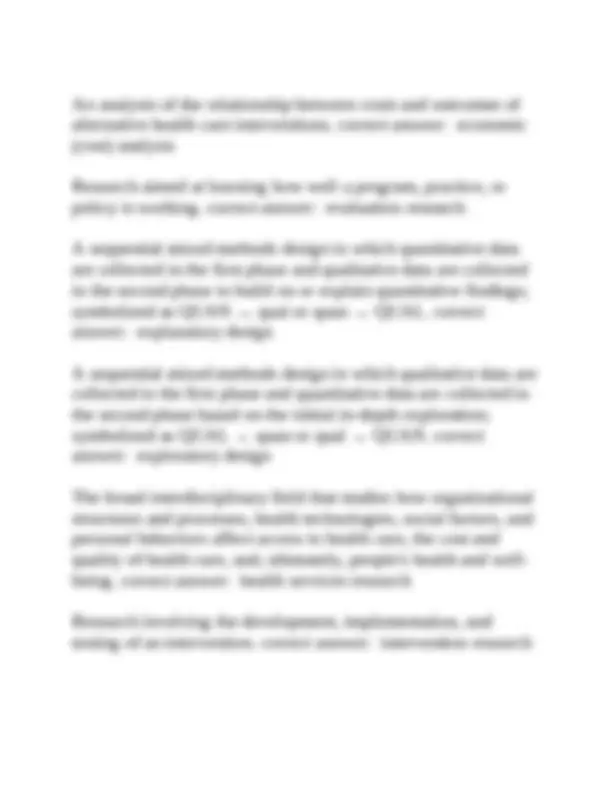
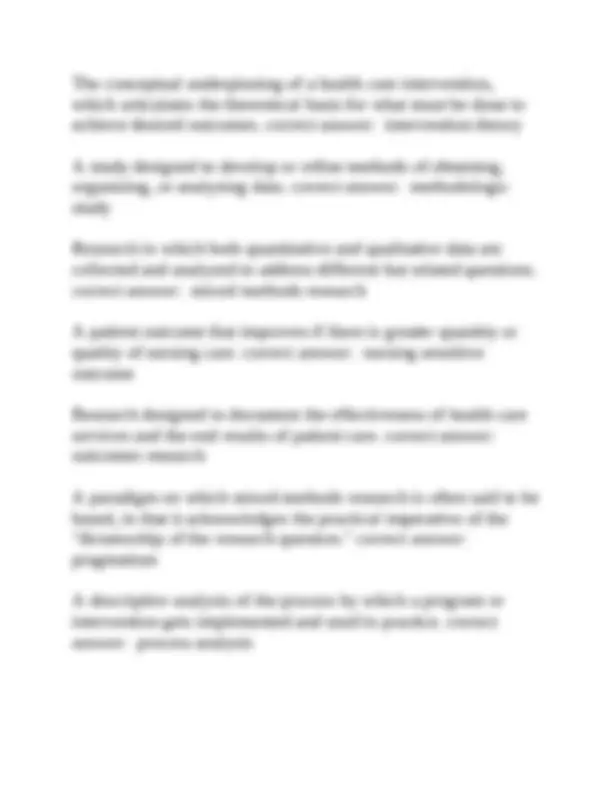
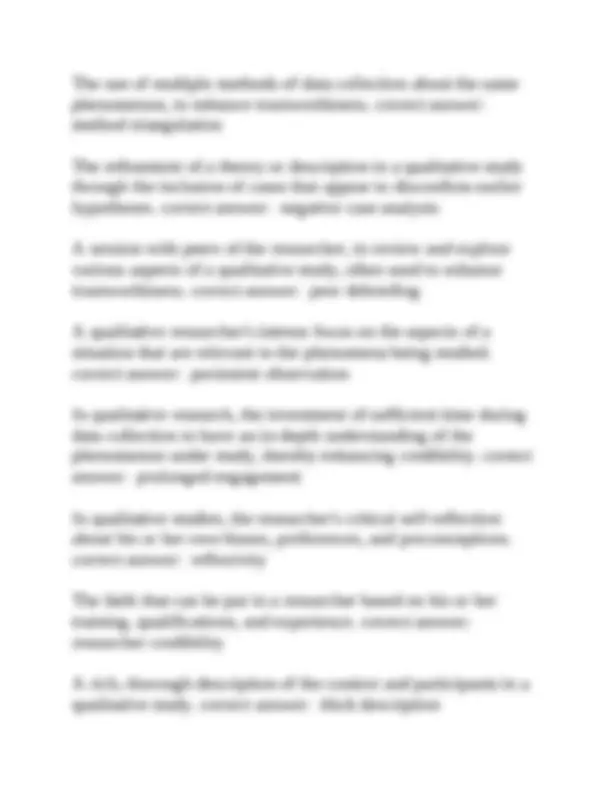
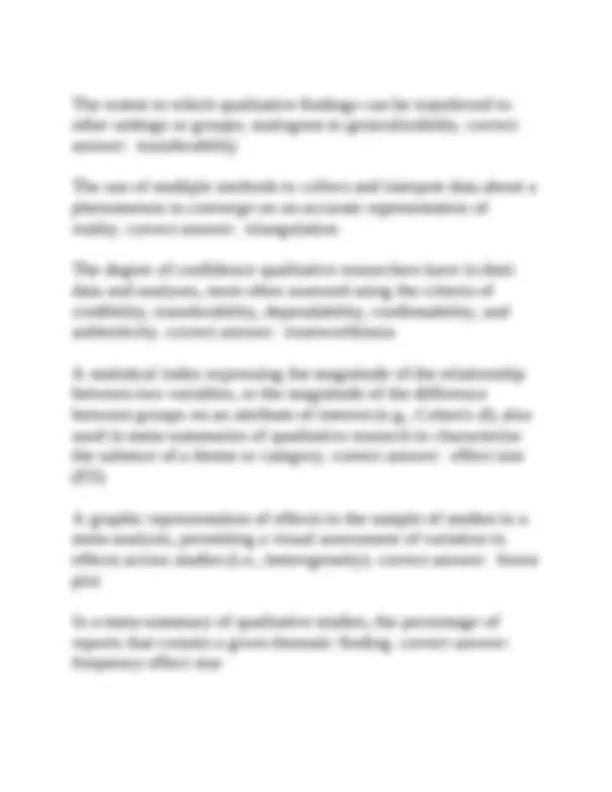
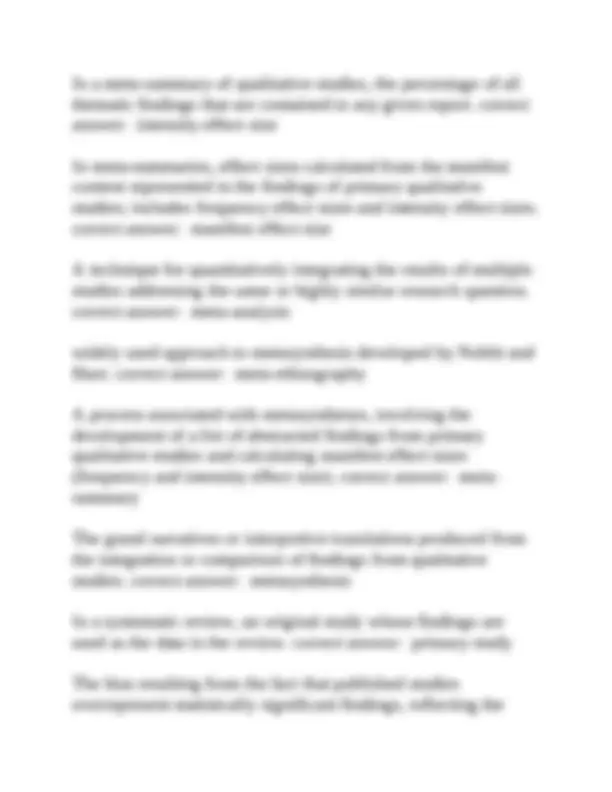
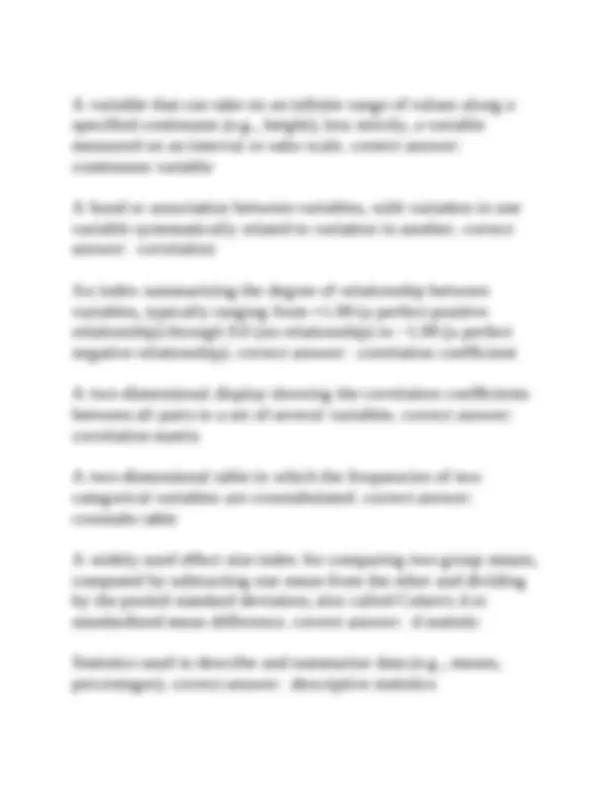
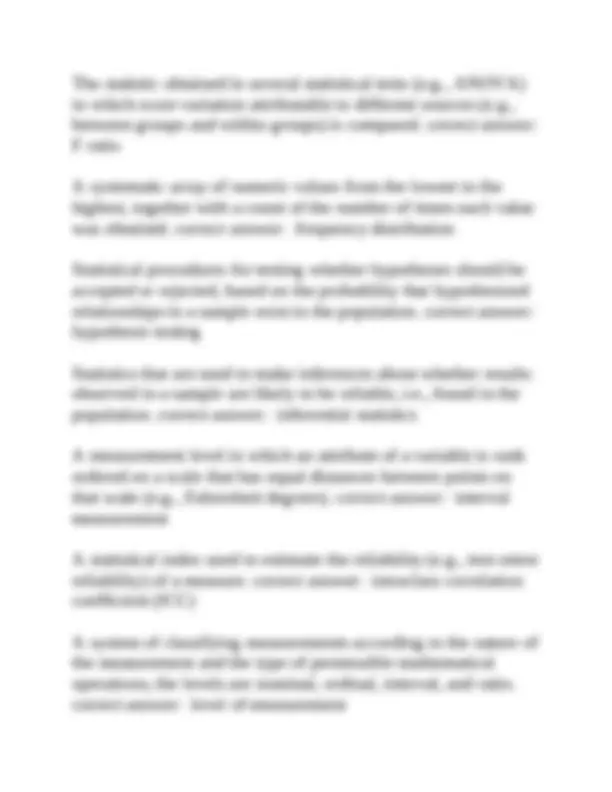
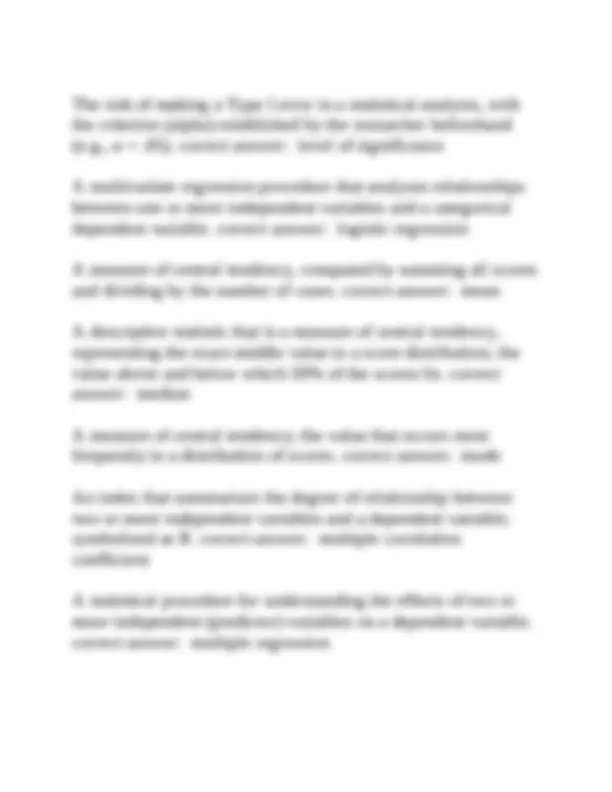
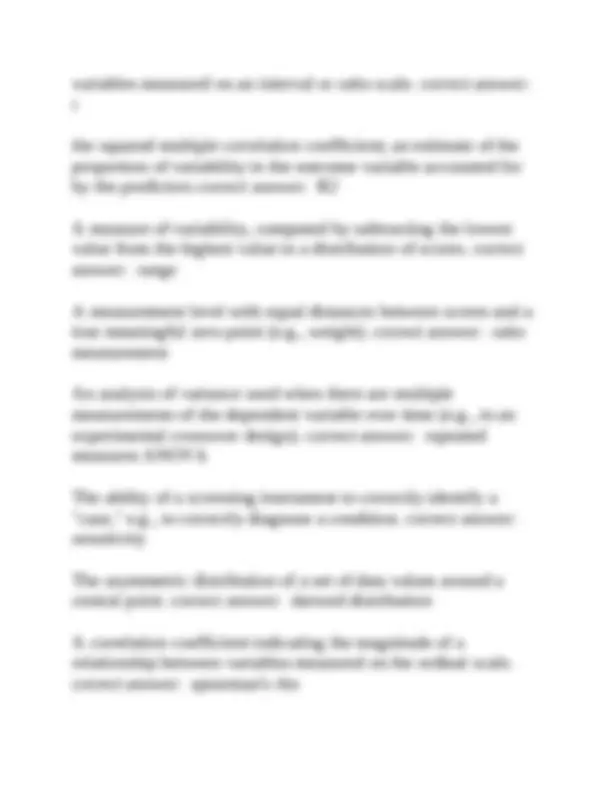
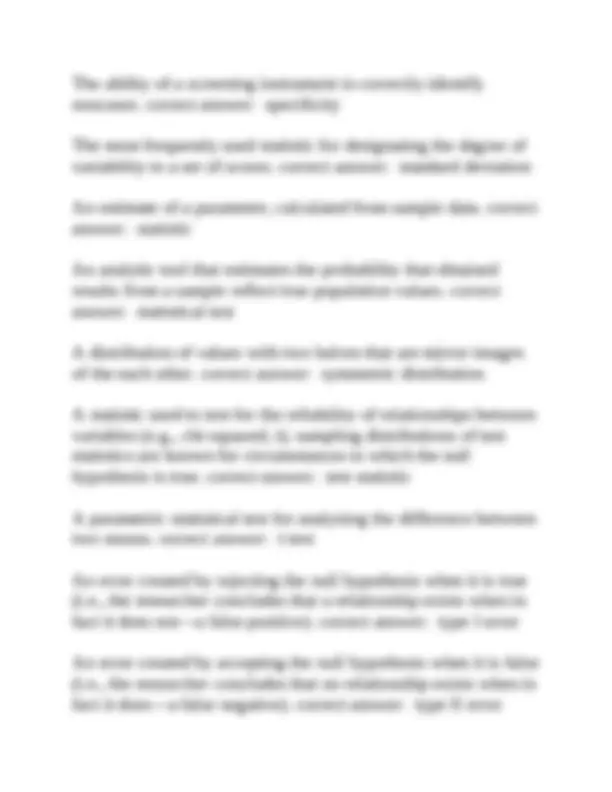
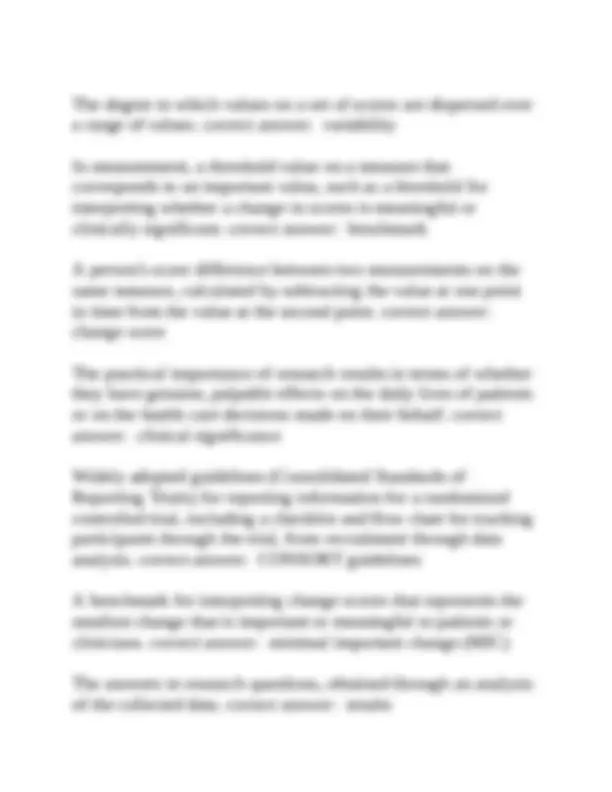
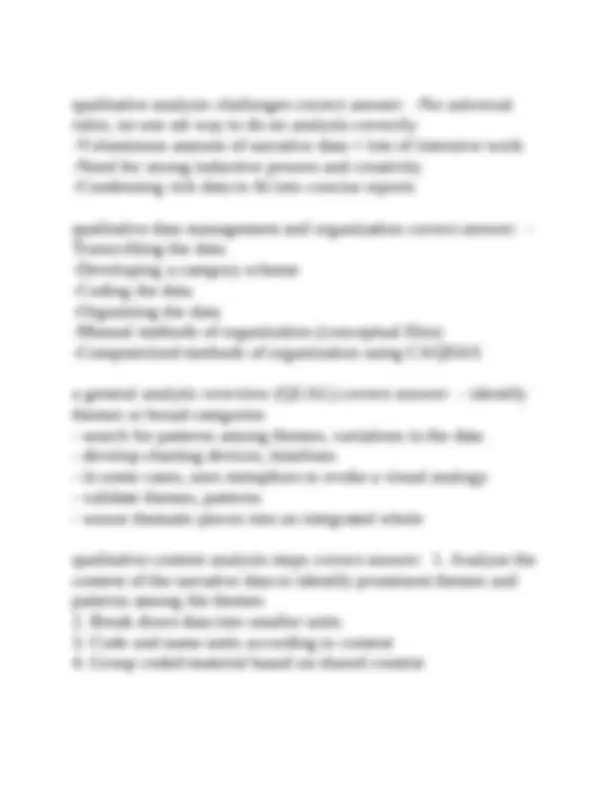

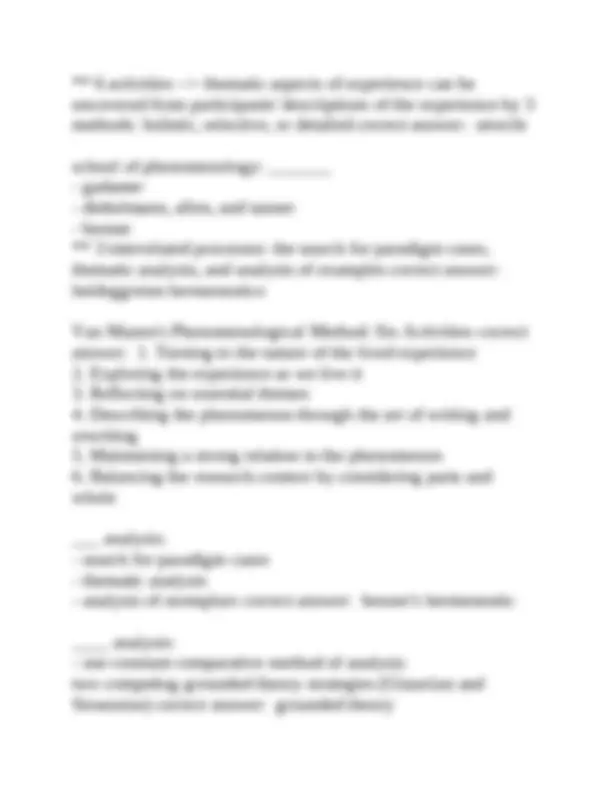
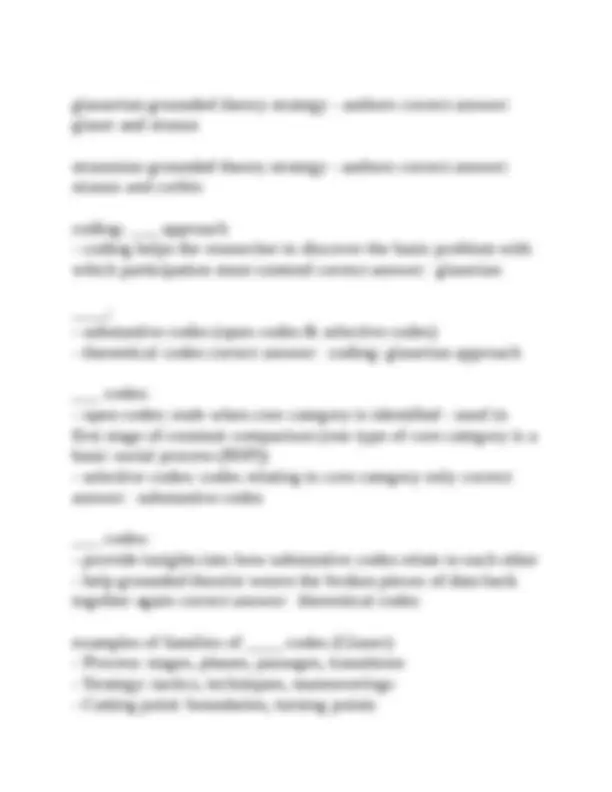
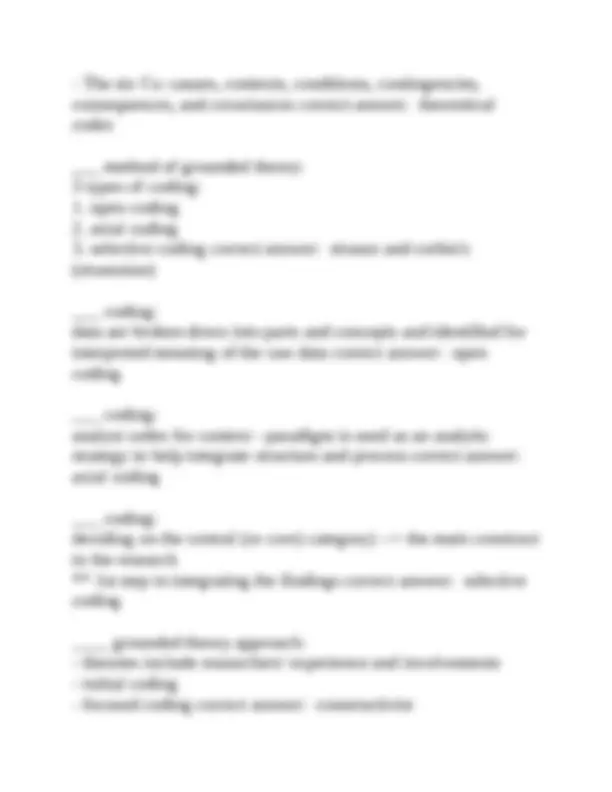
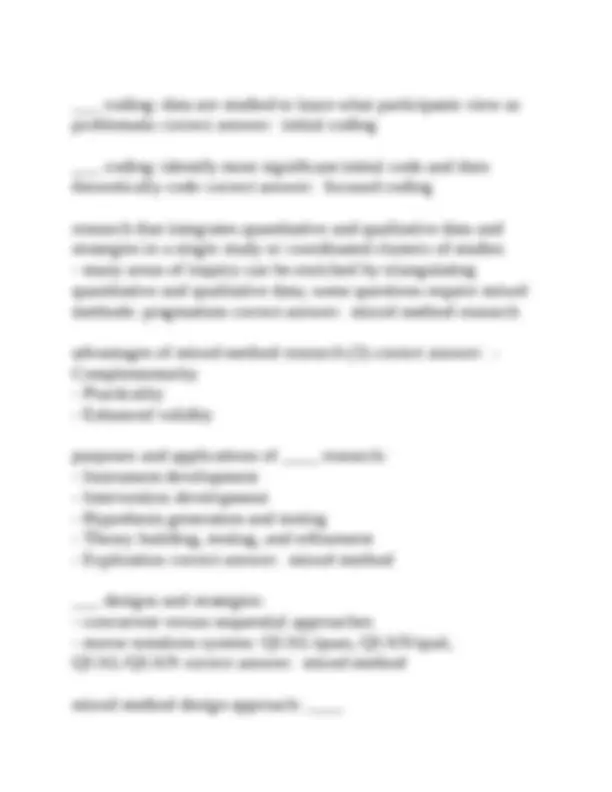
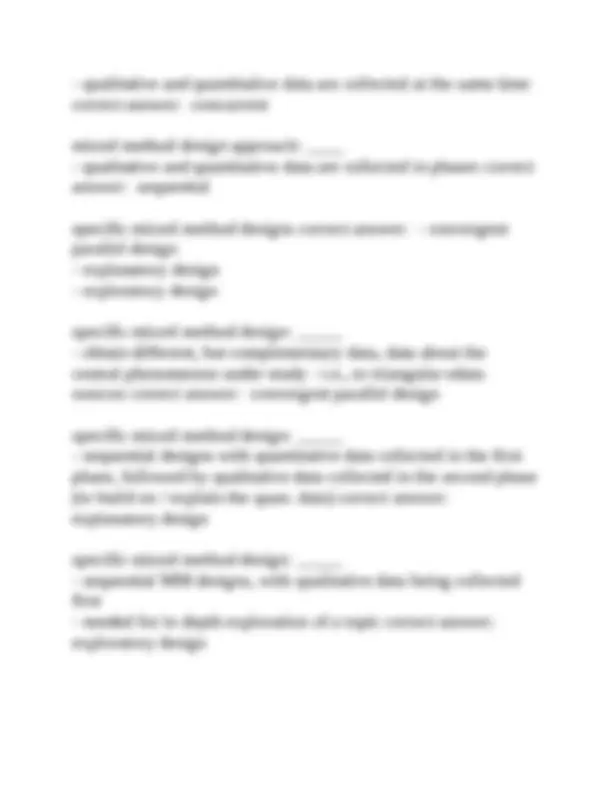
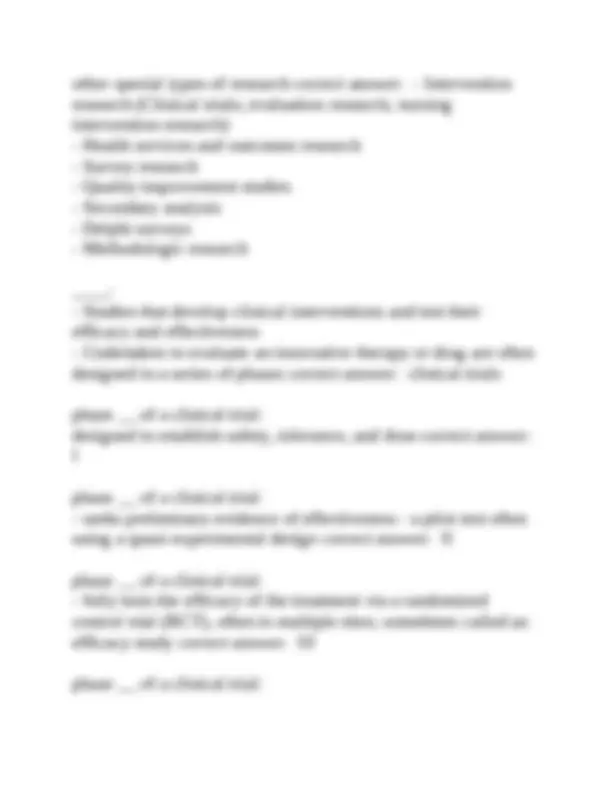

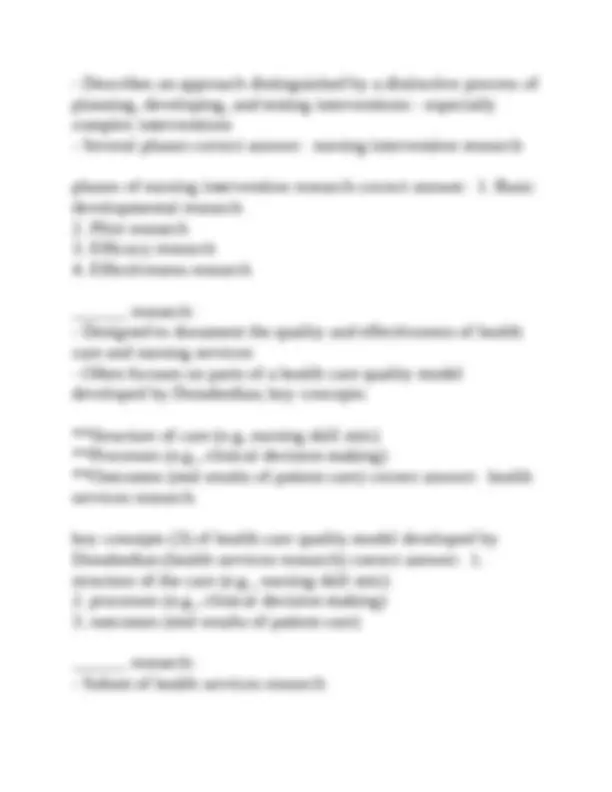
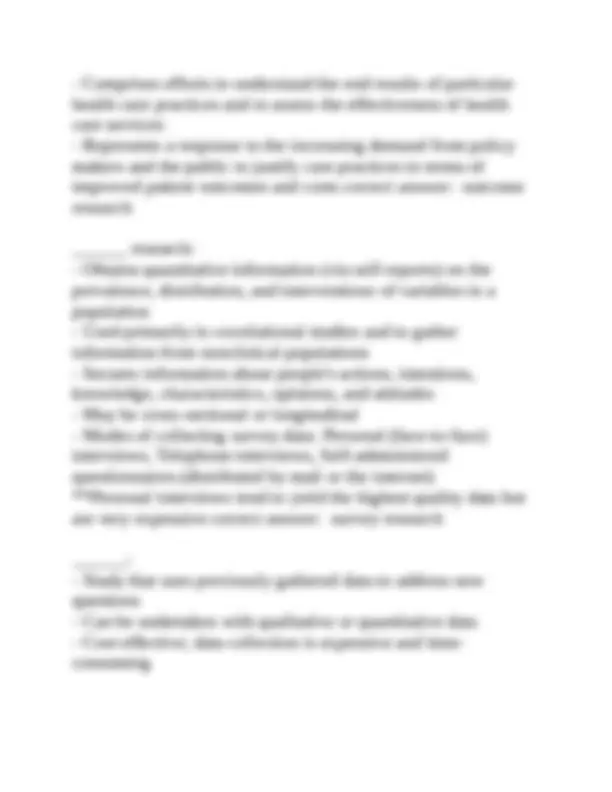
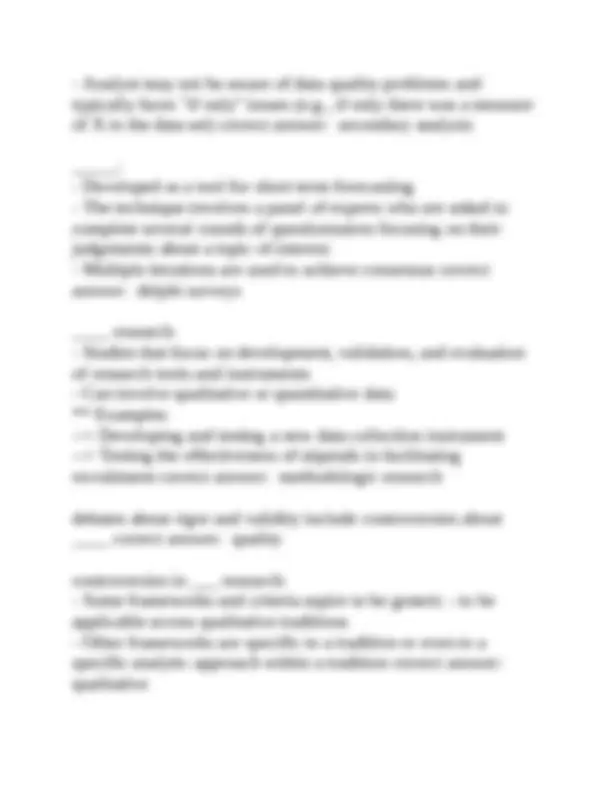
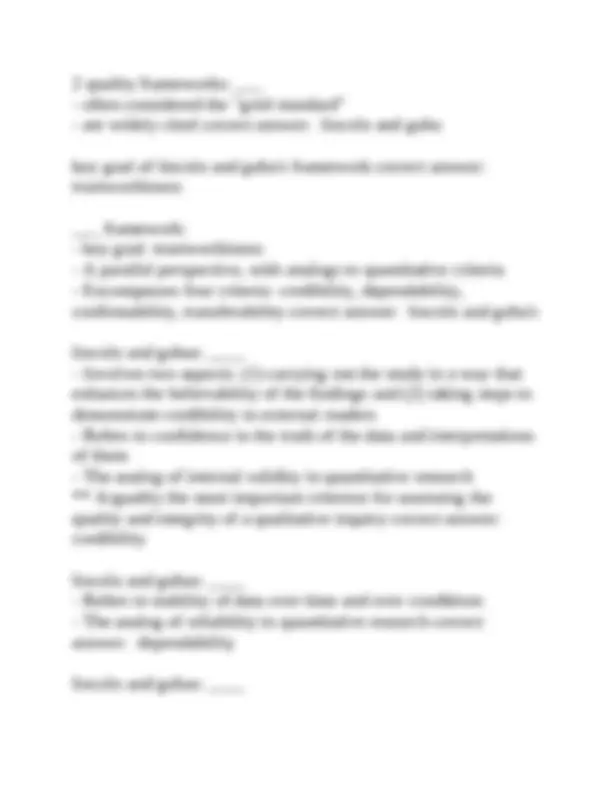
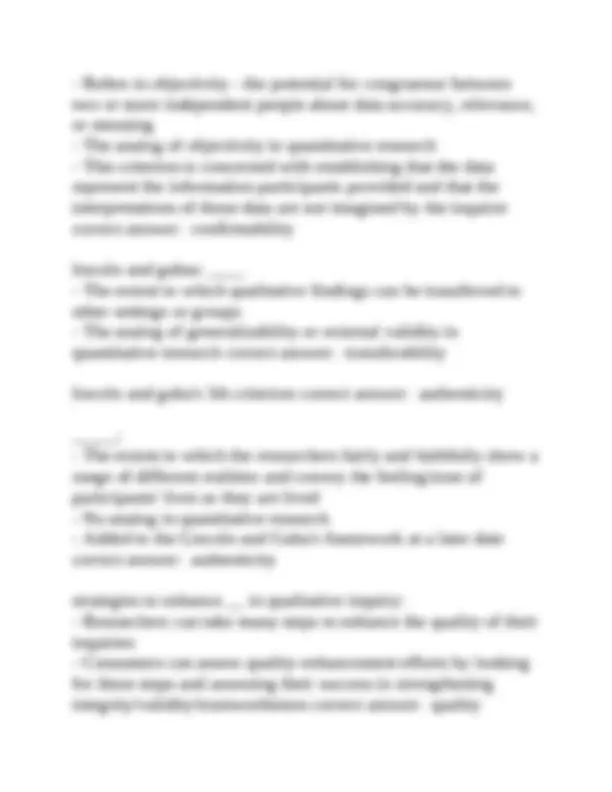
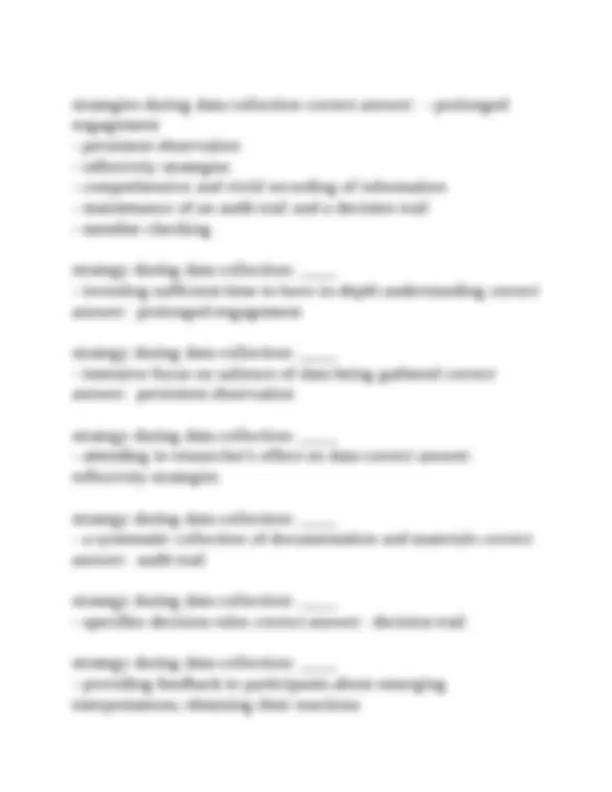
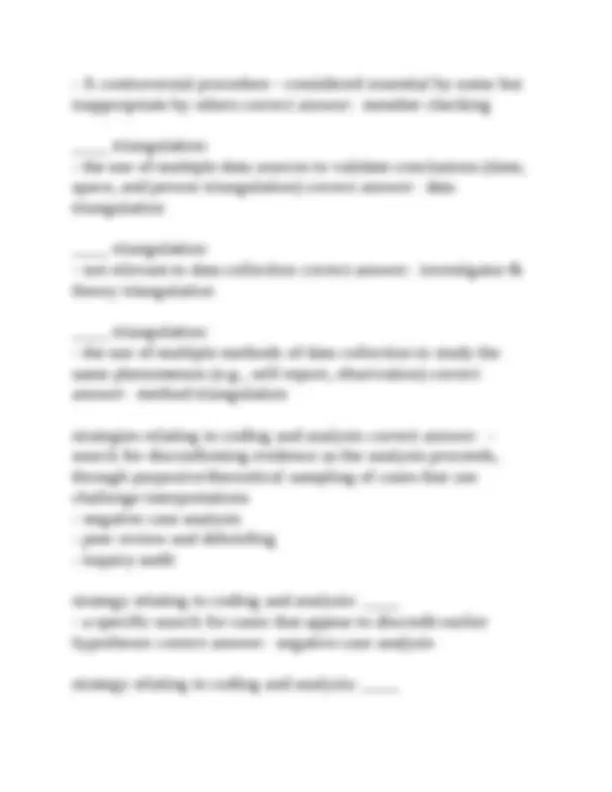
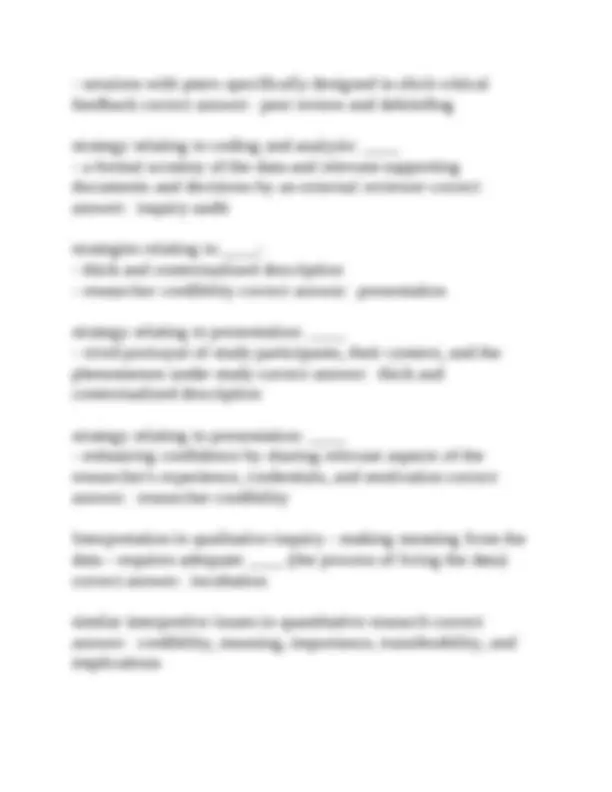
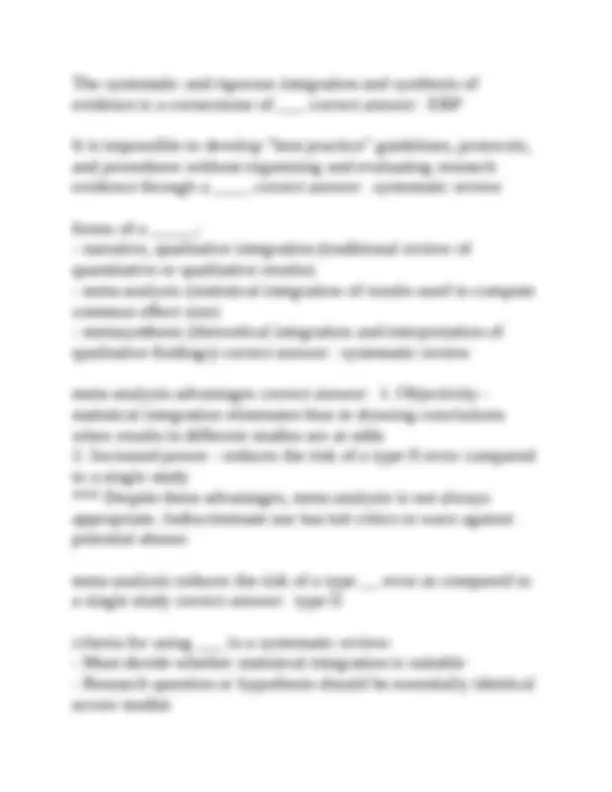
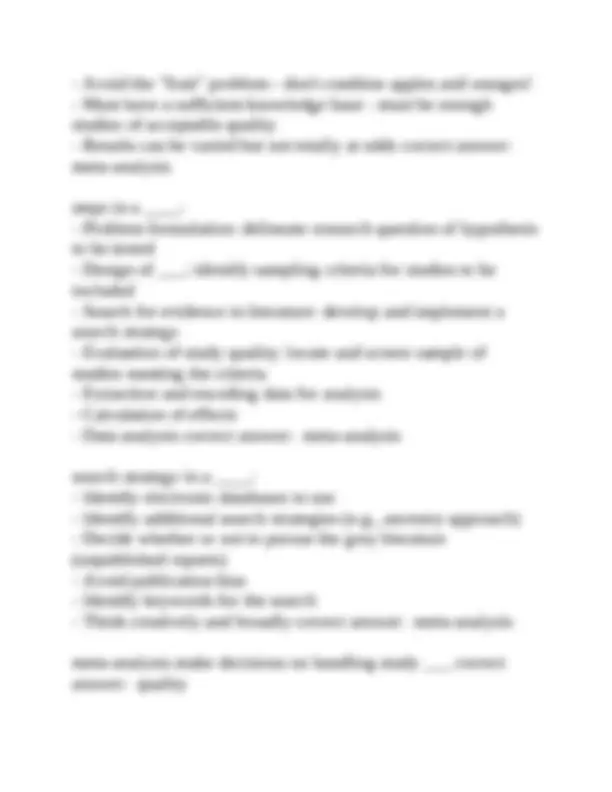
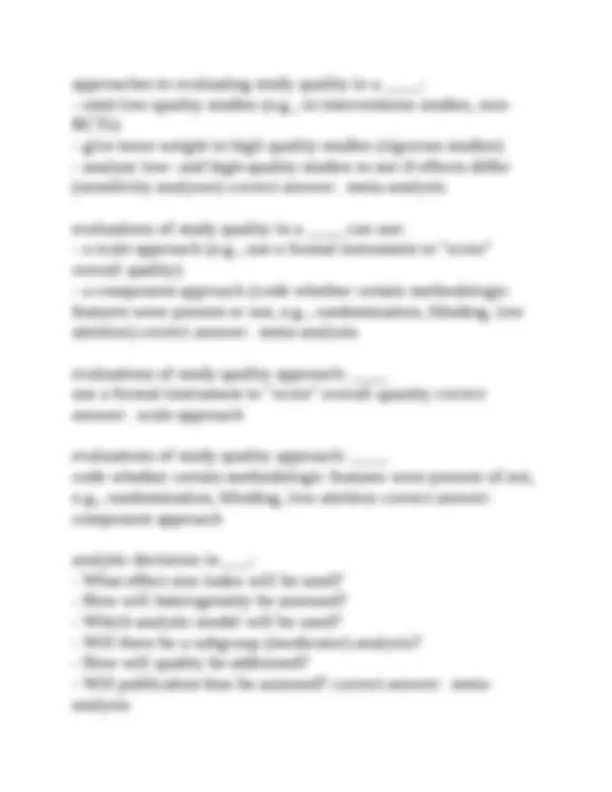
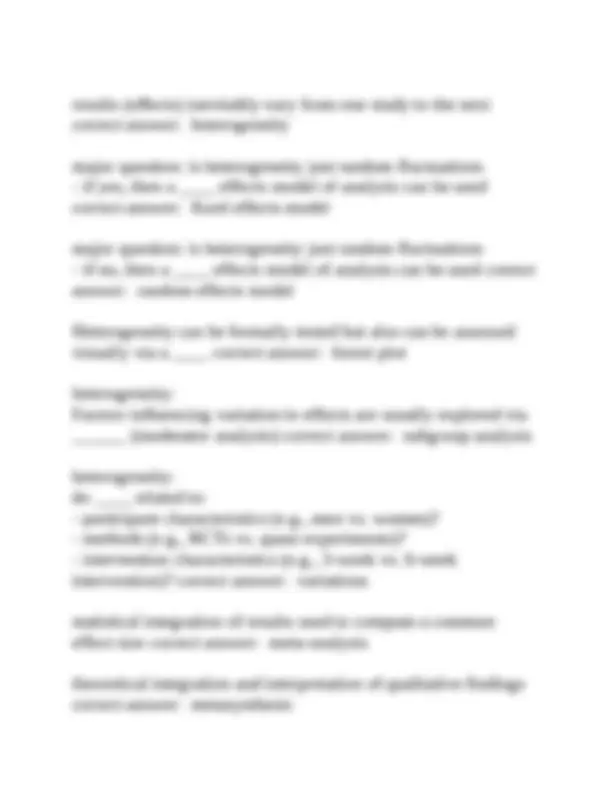
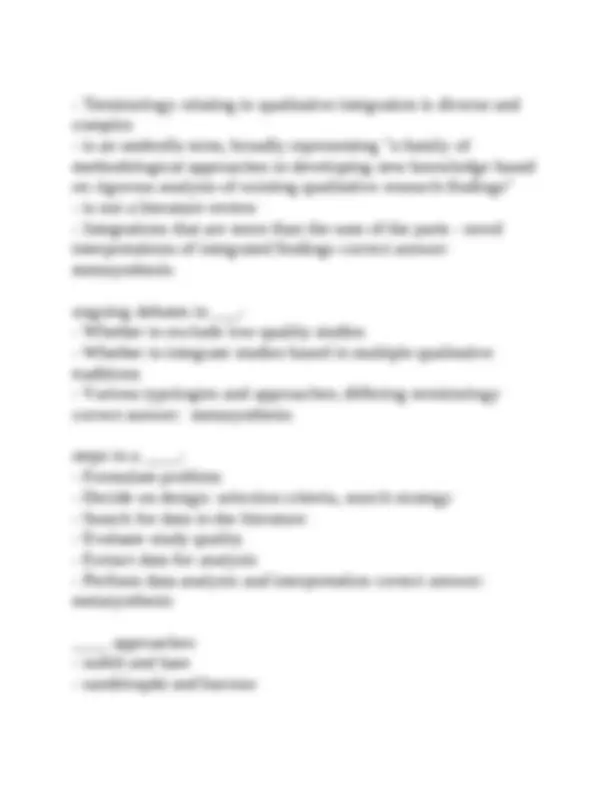
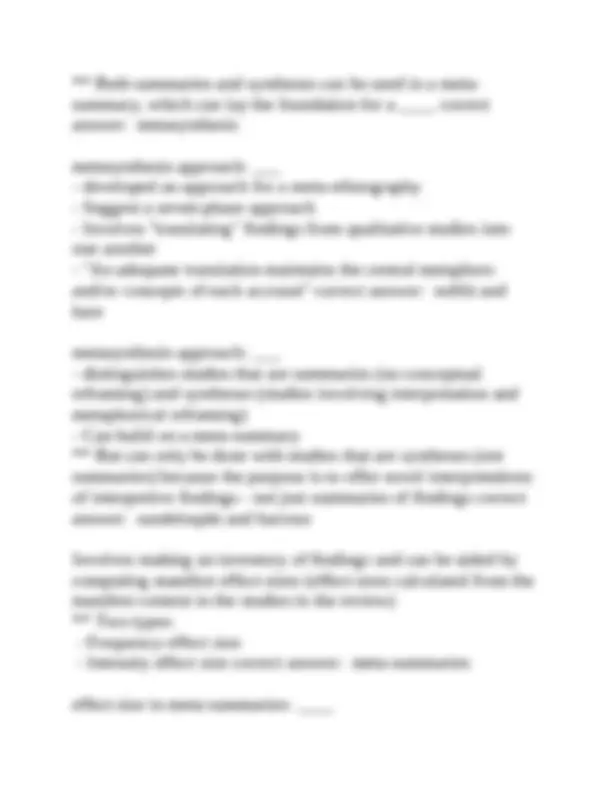
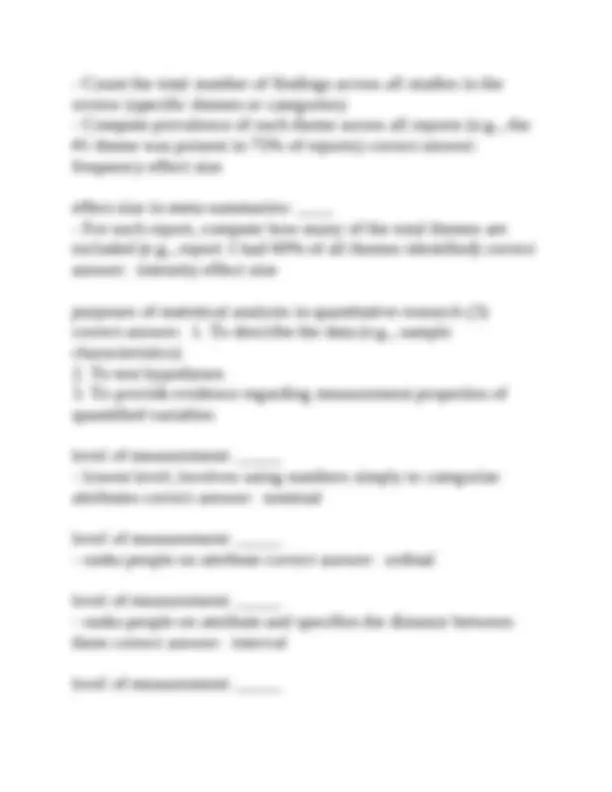
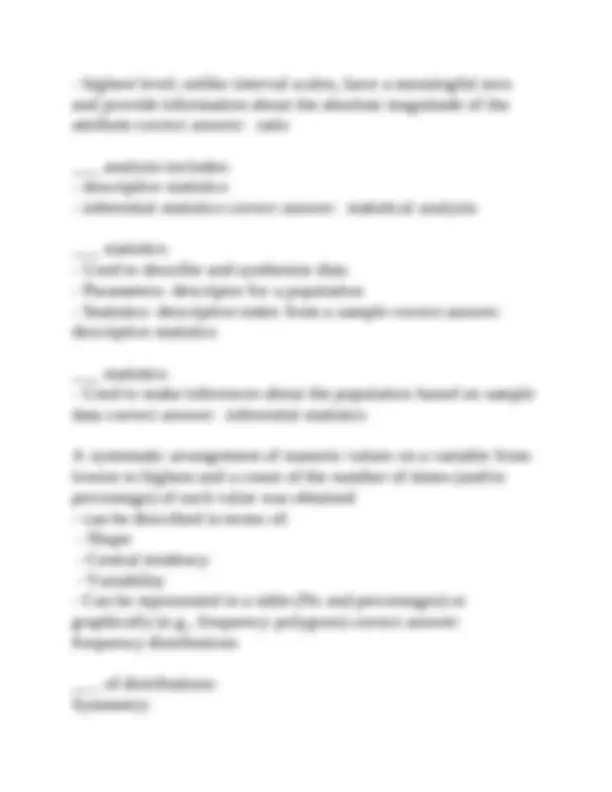
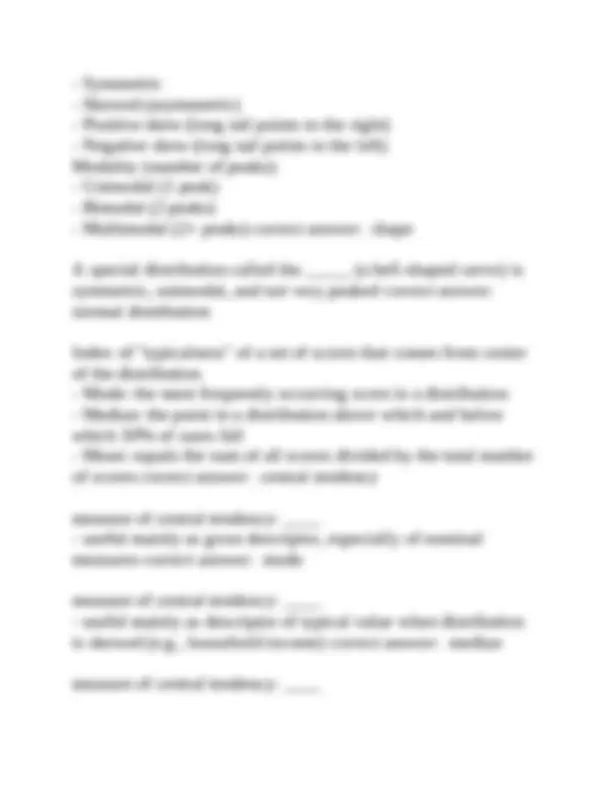
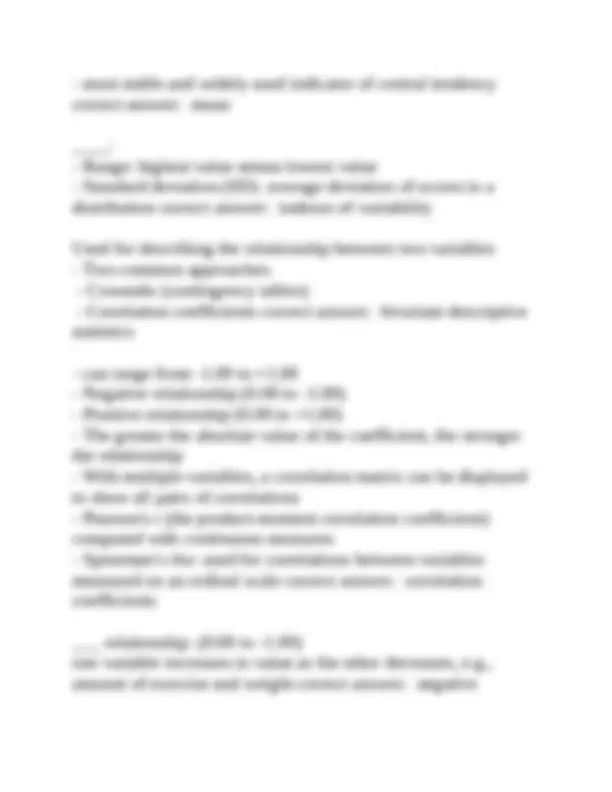
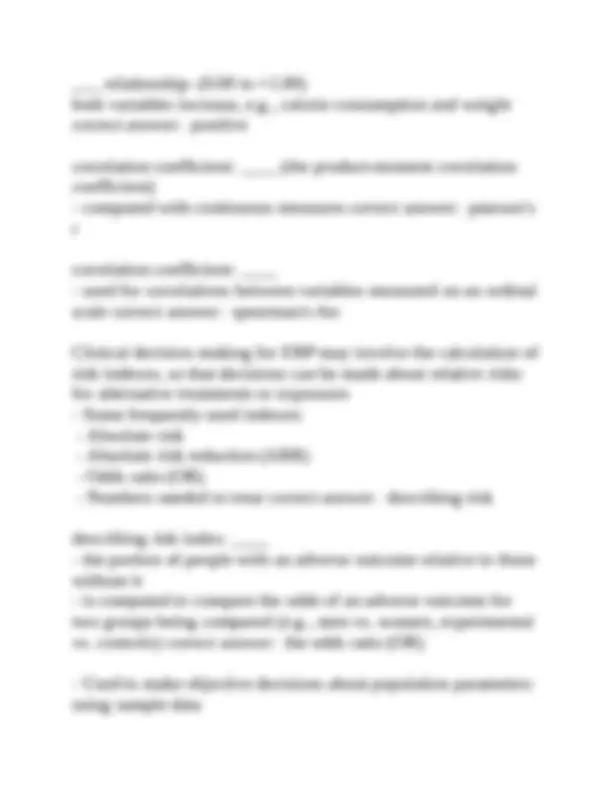
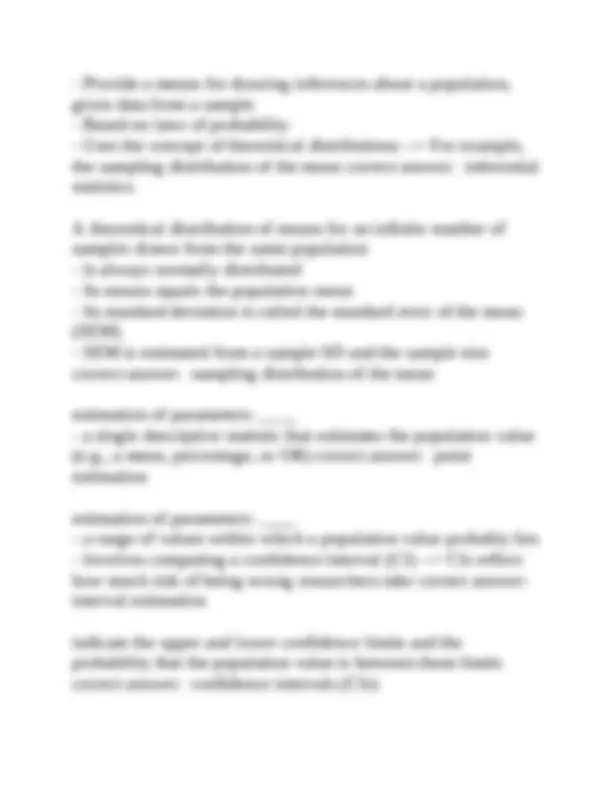
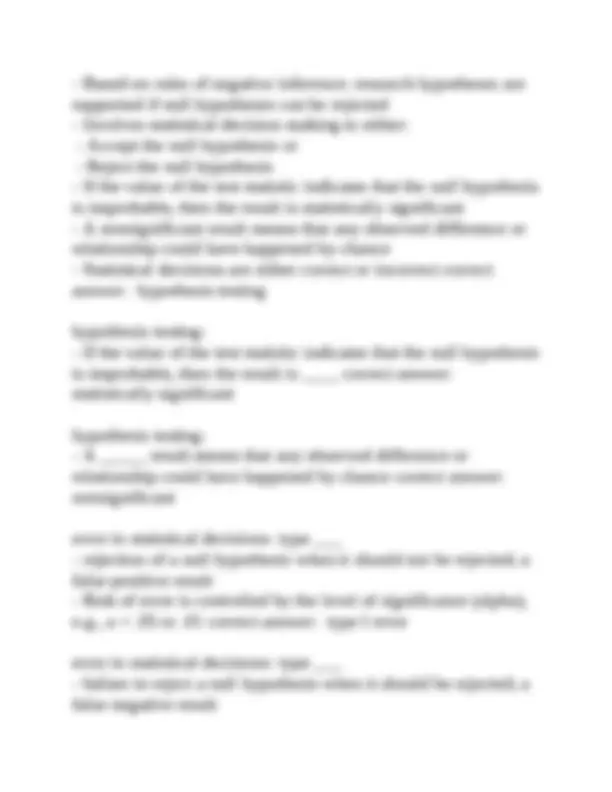
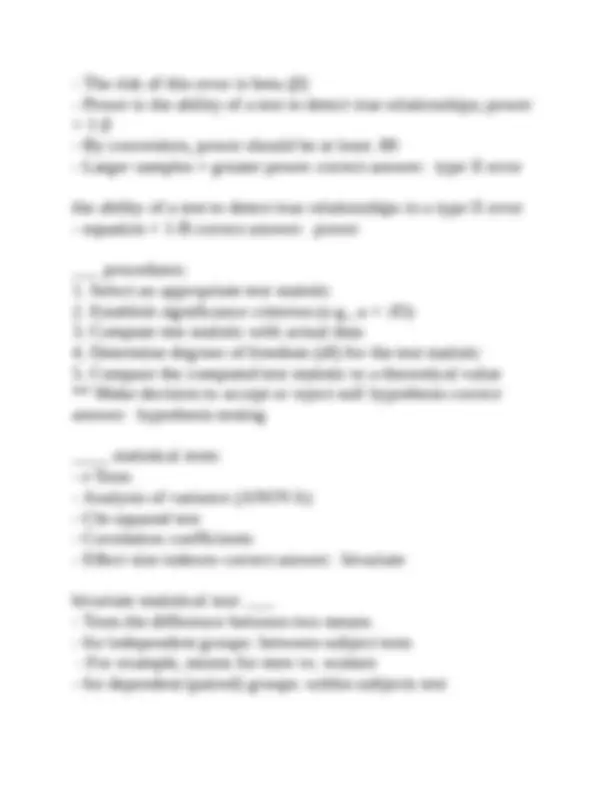
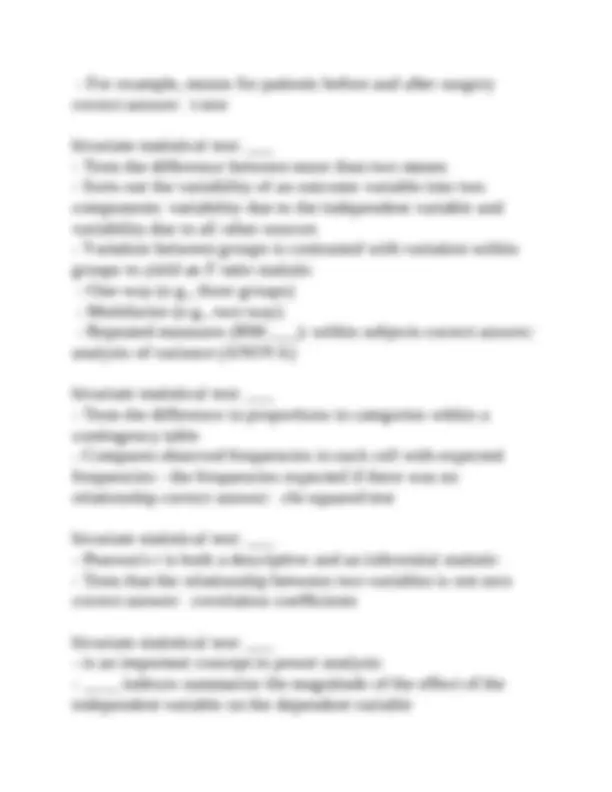
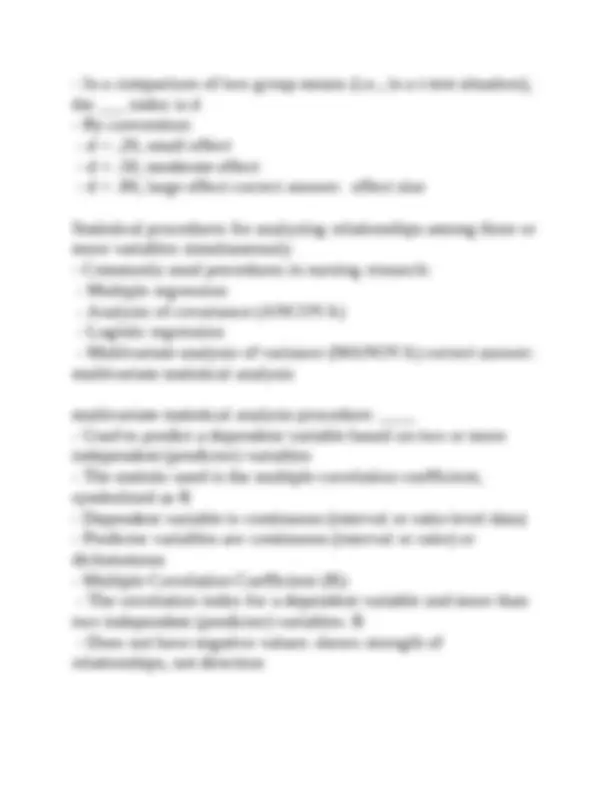
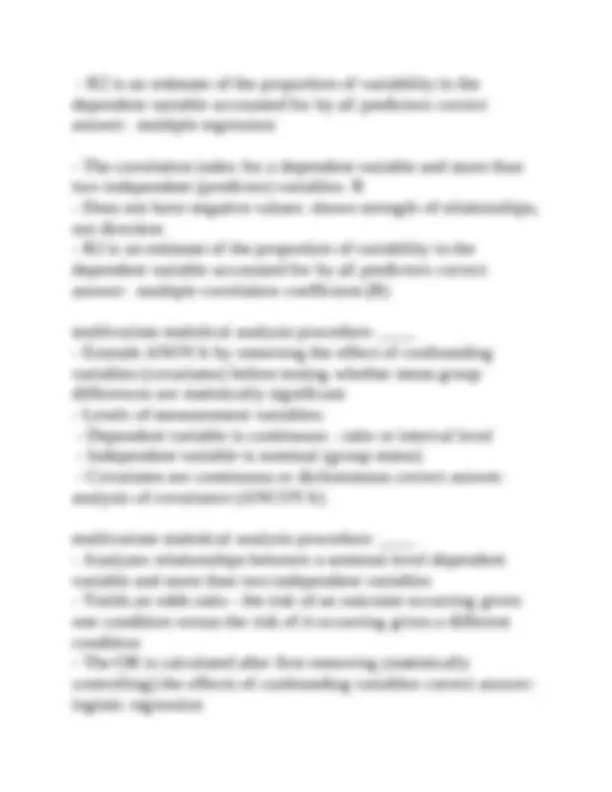
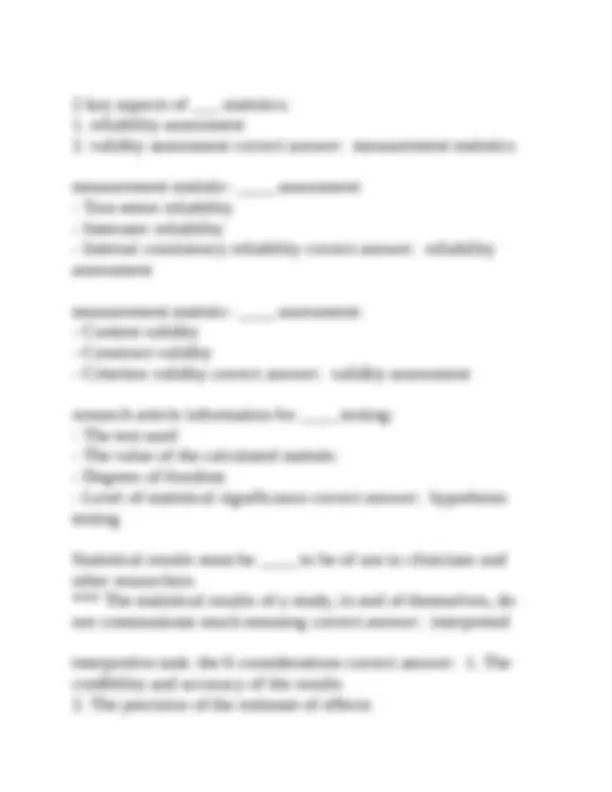
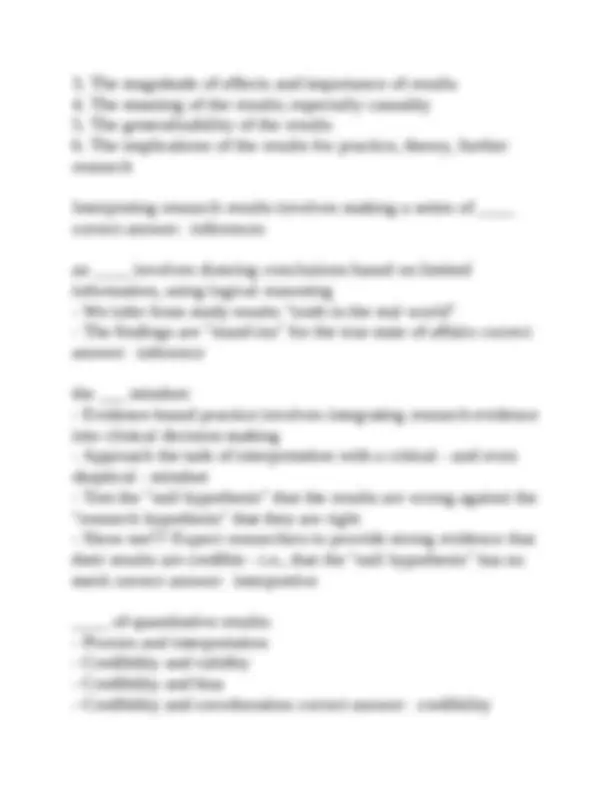
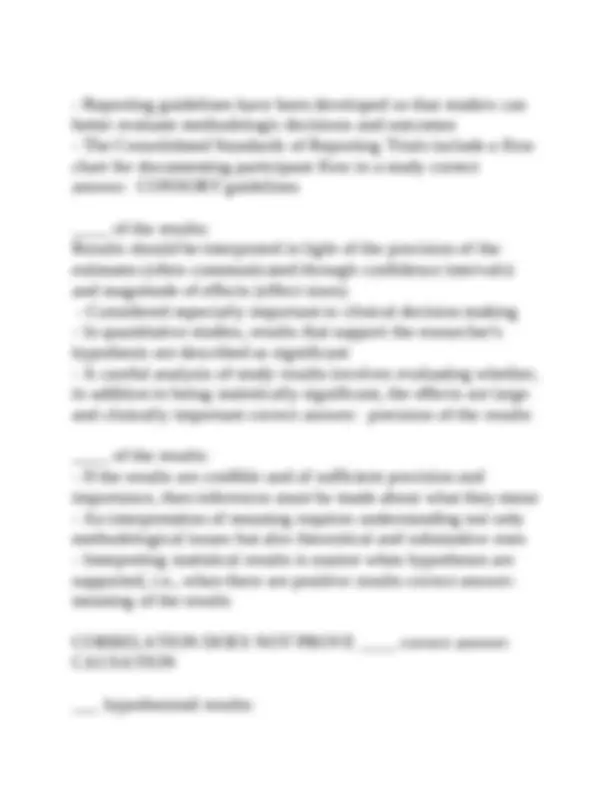
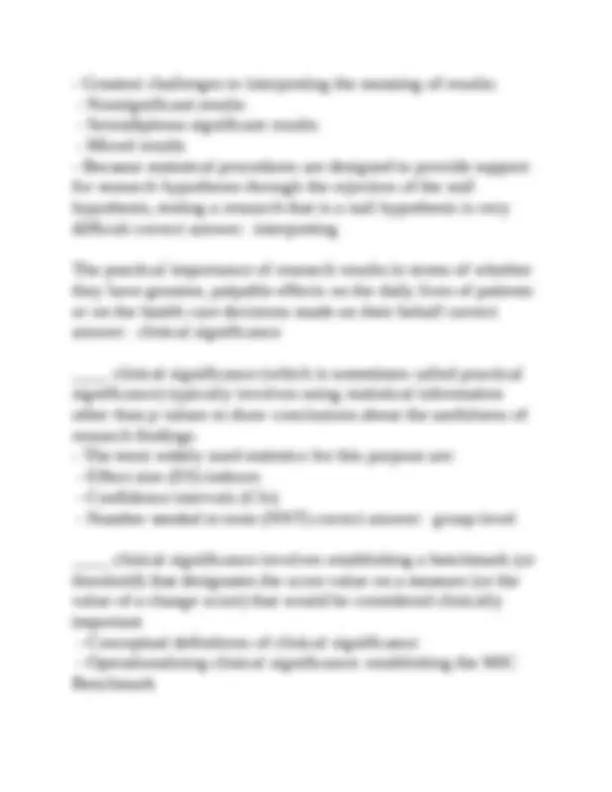



Study with the several resources on Docsity

Earn points by helping other students or get them with a premium plan


Prepare for your exams
Study with the several resources on Docsity

Earn points to download
Earn points by helping other students or get them with a premium plan
Community
Ask the community for help and clear up your study doubts
Discover the best universities in your country according to Docsity users
Free resources
Download our free guides on studying techniques, anxiety management strategies, and thesis advice from Docsity tutors
A comprehensive set of questions and answers related to key concepts in grounded theory and mixed methods research. It covers essential terms, techniques, and methodologies used in qualitative and mixed methods research, offering valuable insights for students and researchers in nursing and related fields. Particularly useful for understanding the different levels of coding in grounded theory, the various types of mixed methods designs, and the criteria for evaluating trustworthiness in qualitative research.
Typology: Exams
1 / 59

This page cannot be seen from the preview
Don't miss anything!




















































The second level of coding in a grounded theory study using the Strauss and Corbin approach, involving the process of categorizing, recategorizing, and condensing first-level codes by connecting a category and its subcategories correct answer: axial coding The central social process emerging through analysis of grounded theory data. correct answer: basic social process (BSP) The main category or pattern of behavior in grounded theory analysis using the Strauss and Corbin approach. correct answer: central category A procedure used in a grounded theory analysis wherein newly collected data are compared in an ongoing fashion with data obtained earlier to refine theoretically relevant categories. correct answer: constant comparison In a grounded theory study, the central phenomenon that is used to integrate all categories of the data. correct answer: core category In ethnographic analysis, a unit or broad category of cultural knowledge. correct answer: domain
A concept in grounded theory that involves comparing new data and new categories with previously existing conceptualizations. correct answer: emergent fit In hermeneutics, the methodologic process in which, to reach understanding, there is continual movement between the parts and the whole of the text that are being analyzed. correct answer: hermeneutic circle A figurative comparison used by some qualitative analysts to evoke a visual or symbolic analogy. correct answer: metaphor The first level of coding in a grounded theory study, referring to the basic descriptive coding of the content of narrative materials. correct answer: open coding In a hermeneutic analysis following the precepts of Benner, a strong exemplar of the phenomenon under study, often used early in the analysis to gain understanding of the phenomenon. correct answer: paradigm case A level of coding in a grounded theory study that begins once the core category has been discovered and involves limiting coding to only those categories related to the core category. correct answer: selective coding broad type of code in which the empirical substance of the topic is conceptualized correct answer: substantive codes In an ethnographic analysis, a system of classifying and organizing terms and concepts, developed to illuminate a
An analysis of the relationship between costs and outcomes of alternative health care interventions. correct answer: economic (cost) analysis Research aimed at learning how well a program, practice, or policy is working. correct answer: evaluation research A sequential mixed methods design in which quantitative data are collected in the first phase and qualitative data are collected in the second phase to build on or explain quantitative findings; symbolized as QUAN → qual or quan → QUAL. correct answer: explanatory design A sequential mixed methods design in which qualitative data are collected in the first phase and quantitative data are collected in the second phase based on the initial in-depth exploration; symbolized as QUAL → quan or qual → QUAN. correct answer: exploratory design The broad interdisciplinary field that studies how organizational structures and processes, health technologies, social factors, and personal behaviors affect access to health care, the cost and quality of health care, and, ultimately, people's health and well- being. correct answer: health services research Research involving the development, implementation, and testing of an intervention. correct answer: intervention research
The conceptual underpinning of a health care intervention, which articulates the theoretical basis for what must be done to achieve desired outcomes. correct answer: intervention theory A study designed to develop or refine methods of obtaining, organizing, or analyzing data. correct answer: methodologic study Research in which both quantitative and qualitative data are collected and analyzed to address different but related questions. correct answer: mixed methods research A patient outcome that improves if there is greater quantity or quality of nursing care. correct answer: nursing sensitive outcome Research designed to document the effectiveness of health care services and the end results of patient care. correct answer: outcomes research A paradigm on which mixed methods research is often said to be based, in that it acknowledges the practical imperative of the "dictatorship of the research question." correct answer: pragmatism A descriptive analysis of the process by which a program or intervention gets implemented and used in practice. correct answer: process analysis
A criterion for evaluating integrity and trustworthiness in qualitative studies, referring to confidence in the truth of the data; analogous to internal validity in quantitative research. correct answer: credibility The use of multiple data sources for the purpose of validating conclusions. correct answer: data triangulation A criterion for evaluating integrity in qualitative studies, referring to the stability of data over time and over conditions; analogous to reliability in quantitative research. correct answer: dependability A concept used in qualitative research that concerns a case that challenges the researchers' conceptualizations; sometimes used in a sampling strategy. correct answer: disconfirming cases An independent scrutiny of qualitative data and relevant supporting documents by an external reviewer to determine the dependability and confirmability of qualitative data. correct answer: inquiry audit The use of two or more researchers to analyze and interpret a data set, to enhance trustworthiness. correct answer: investigator triangulation A method of validating the credibility of qualitative data through debriefings and discussions with informants. correct answer: member check
The use of multiple methods of data collection about the same phenomenon, to enhance trustworthiness. correct answer: method triangulation The refinement of a theory or description in a qualitative study through the inclusion of cases that appear to disconfirm earlier hypotheses. correct answer: negative case analysis A session with peers of the researcher, to review and explore various aspects of a qualitative study, often used to enhance trustworthiness. correct answer: peer debriefing A qualitative researcher's intense focus on the aspects of a situation that are relevant to the phenomena being studied. correct answer: persistent observation In qualitative research, the investment of sufficient time during data collection to have an in-depth understanding of the phenomenon under study, thereby enhancing credibility. correct answer: prolonged engagement In qualitative studies, the researcher's critical self-reflection about his or her own biases, preferences, and preconceptions. correct answer: reflexivity The faith that can be put in a researcher based on his or her training, qualifications, and experience. correct answer: researcher credibility A rich, thorough description of the context and participants in a qualitative study. correct answer: thick description
In a meta-summary of qualitative studies, the percentage of all thematic findings that are contained in any given report. correct answer: intensity effect size In meta-summaries, effect sizes calculated from the manifest content represented in the findings of primary qualitative studies; includes frequency effect sizes and intensity effect sizes. correct answer: manifest effect size A technique for quantitatively integrating the results of multiple studies addressing the same or highly similar research question. correct answer: meta-analysis widely used approach to metasynthesis developed by Noblit and Hare. correct answer: meta-ethnography A process associated with metasyntheses, involving the development of a list of abstracted findings from primary qualitative studies and calculating manifest effect sizes (frequency and intensity effect size). correct answer: meta- summary The grand narratives or interpretive translations produced from the integration or comparison of findings from qualitative studies. correct answer: metasynthesis In a systematic review, an original study whose findings are used as the data in the review. correct answer: primary study The bias resulting from the fact that published studies overrepresent statistically significant findings, reflecting the
tendency of researchers, reviewers, and editors to not publish nonsignificant results. correct answer: publication bias diversity in effects across studies
A variable that can take on an infinite range of values along a specified continuum (e.g., height); less strictly, a variable measured on an interval or ratio scale. correct answer: continuous variable A bond or association between variables, with variation in one variable systematically related to variation in another. correct answer: correlation An index summarizing the degree of relationship between variables, typically ranging from +1.00 (a perfect positive relationship) through 0.0 (no relationship) to −1.00 (a perfect negative relationship). correct answer: correlation coefficient A two-dimensional display showing the correlation coefficients between all pairs in a set of several variables. correct answer: correlation matrix A two-dimensional table in which the frequencies of two categorical variables are crosstabulated. correct answer: crosstabs table A widely used effect size index for comparing two group means, computed by subtracting one mean from the other and dividing by the pooled standard deviation; also called Cohen's d or standardized mean difference. correct answer: d statistic Statistics used to describe and summarize data (e.g., means, percentages). correct answer: descriptive statistics
The statistic obtained in several statistical tests (e.g., ANOVA) in which score variation attributable to different sources (e.g., between groups and within groups) is compared. correct answer: F ratio A systematic array of numeric values from the lowest to the highest, together with a count of the number of times each value was obtained. correct answer: frequency distribution Statistical procedures for testing whether hypotheses should be accepted or rejected, based on the probability that hypothesized relationships in a sample exist in the population. correct answer: hypothesis testing Statistics that are used to make inferences about whether results observed in a sample are likely to be reliable, i.e., found in the population. correct answer: inferential statistics A measurement level in which an attribute of a variable is rank ordered on a scale that has equal distances between points on that scale (e.g., Fahrenheit degrees). correct answer: interval measurement A statistical index used to estimate the reliability (e.g., test-retest reliability) of a measure. correct answer: intraclass correlation coefficient (ICC) A system of classifying measurements according to the nature of the measurement and the type of permissible mathematical operations; the levels are nominal, ordinal, interval, and ratio. correct answer: level of measurement
Statistical procedures designed to analyze the relationships among three or more variables (e.g., multiple regression, ANCOVA). correct answer: multivariate statistics The symbol designating the total number of subjects (e.g., "the total N was 500"). correct answer: N The lowest level of measurement involving the assignment of characteristics into categories (e.g., males = 1; females = 2; other = 3). correct answer: nominal measurement The result of a statistical test indicating that group differences or an observed relationship could have occurred by chance, at a given level of significance; sometimes abbreviated as NS; sometimes called negative results. correct answer: nonsignificant results (NS) A theoretical distribution that is bell-shaped, symmetrical, and not too peaked. correct answer: normal distribution An estimate of how many people would need to receive an intervention to prevent one undesirable outcome, computed by dividing 1 by the value of the absolute risk reduction. correct answer: number needed to treat (NNT) The ratio of one odds to another odds, e.g., the ratio of the odds of an event in one group to the odds of an event in another group; an odds ratio of 1.0 indicates no difference between groups. correct answer: odds ratio (OR)
A measurement level that rank orders phenomena along some dimension. correct answer: ordinal measurement In statistical testing, the probability that the obtained results are due to chance alone; the probability of a Type I error. correct answer: p value A characteristic of a population (e.g., the mean age of all Canadian citizens). correct answer: parameter statistical inference technique used to estimate a population parameter correct answer: parameter estimation A correlation coefficient designating the magnitude of relationship between two interval- or ratio-level variables; also called the product-moment correlation. correct answer: pearson's r A relationship between two variables in which high values on one variable tend to be associated with high values on the other (e.g., as physical activity increases, pulse rate increases). correct answer: positive relationship In regression analyses, a term often used in lieu of independent variable; predictor variables are used to predict the value of the dependent (outcome) variable. correct answer: predictor variable The symbol for a bivariate correlation coefficient, summarizing the magnitude and direction of a relationship between two
The ability of a screening instrument to correctly identify noncases. correct answer: specificity The most frequently used statistic for designating the degree of variability in a set of scores. correct answer: standard deviation An estimate of a parameter, calculated from sample data. correct answer: statistic An analytic tool that estimates the probability that obtained results from a sample reflect true population values. correct answer: statistical test A distribution of values with two halves that are mirror images of the each other. correct answer: symmetric distribution A statistic used to test for the reliability of relationships between variables (e.g., chi-squared, t); sampling distributions of test statistics are known for circumstances in which the null hypothesis is true. correct answer: test statistic A parametric statistical test for analyzing the difference between two means. correct answer: t-test An error created by rejecting the null hypothesis when it is true (i.e., the researcher concludes that a relationship exists when in fact it does not—a false positive). correct answer: type I error An error created by accepting the null hypothesis when it is false (i.e., the researcher concludes that no relationship exists when in fact it does—a false negative). correct answer: type II error
The degree to which values on a set of scores are dispersed over a range of values. correct answer: variability In measurement, a threshold value on a measure that corresponds to an important value, such as a threshold for interpreting whether a change in scores is meaningful or clinically significant. correct answer: benchmark A person's score difference between two measurements on the same measure, calculated by subtracting the value at one point in time from the value at the second point. correct answer: change score The practical importance of research results in terms of whether they have genuine, palpable effects on the daily lives of patients or on the health care decisions made on their behalf. correct answer: clinical significance Widely adopted guidelines (Consolidated Standards of Reporting Trials) for reporting information for a randomized controlled trial, including a checklist and flow chart for tracking participants through the trial, from recruitment through data analysis. correct answer: CONSORT guidelines A benchmark for interpreting change scores that represents the smallest change that is important or meaningful to patients or clinicians. correct answer: minimal important change (MIC) The answers to research questions, obtained through an analysis of the collected data. correct answer: results